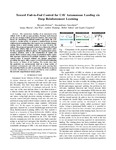The 2018 International Conference on Unmanned Aircraft Systems
| dc.contributor.author | Polvara, R | |
| dc.contributor.author | Patacchiola, M | |
| dc.contributor.author | sharma, sanjay | |
| dc.contributor.author | Wan, Jian | |
| dc.contributor.author | Manning, Andrew | |
| dc.contributor.author | Sutton, R | |
| dc.contributor.author | Cangelosi, Angelo | |
| dc.date.accessioned | 2018-07-05T08:49:17Z | |
| dc.date.issued | 2018 | |
| dc.identifier.uri | http://hdl.handle.net/10026.1/11801 | |
| dc.description.abstract |
The autonomous landing of an unmanned aerial vehicle (UAV) is still an open problem. Previous work focused on the use of hand-crafted geometric features and sensor-data fusion for identifying a fiducial marker and guide the UAV toward it. In this article we propose a method based on deep reinforcement learning that only requires low-resolution images coming from a down looking camera in order to drive the vehicle. The proposed approach is based on a hierarchy of Deep Q-Networks (DQNs) that are used as high-end control policy for the navigation in different phases. We implemented various technical solutions, such as the combination of vanilla and double DQNs trained using a form of prioritized buffer replay that separates experiences in multiple containers. The optimal control policy is learned without any human supervision, providing the agent with a sparse reward feedback indicating the success or failure of the landing. The results show that the quadrotor can autonomously land on a large variety of simulated environments and with relevant noise, proving that the underline DQNs are able to generalise effectively on unseen scenarios. Furthermore, it was proved that in some conditions the network outperformed human pilots. | |
| dc.language.iso | en | |
| dc.title | The 2018 International Conference on Unmanned Aircraft Systems | |
| dc.type | conference | |
| dc.type | inproceedings | |
| plymouth.date-start | 2018-06-12 | |
| plymouth.date-finish | 2018-06-15 | |
| plymouth.organisational-group | /Plymouth | |
| plymouth.organisational-group | /Plymouth/Faculty of Science and Engineering | |
| plymouth.organisational-group | /Plymouth/Faculty of Science and Engineering/School of Engineering, Computing and Mathematics | |
| plymouth.organisational-group | /Plymouth/REF 2021 Researchers by UoA | |
| plymouth.organisational-group | /Plymouth/REF 2021 Researchers by UoA/UoA07 Earth Systems and Environmental Sciences | |
| plymouth.organisational-group | /Plymouth/REF 2021 Researchers by UoA/UoA12 Engineering | |
| plymouth.organisational-group | /Plymouth/Research Groups | |
| plymouth.organisational-group | /Plymouth/Research Groups/Institute of Health and Community | |
| plymouth.organisational-group | /Plymouth/Research Groups/Marine Institute | |
| plymouth.organisational-group | /Plymouth/Users by role | |
| plymouth.organisational-group | /Plymouth/Users by role/Academics | |
| plymouth.organisational-group | /Plymouth/Users by role/Researchers in ResearchFish submission | |
| dcterms.dateAccepted | 2018-01-01 | |
| dc.rights.embargodate | 2022-1-25 | |
| dc.rights.embargoperiod | Not known | |
| rioxxterms.licenseref.uri | http://www.rioxx.net/licenses/all-rights-reserved | |
| rioxxterms.licenseref.startdate | 2018 | |
| rioxxterms.type | Conference Paper/Proceeding/Abstract |


